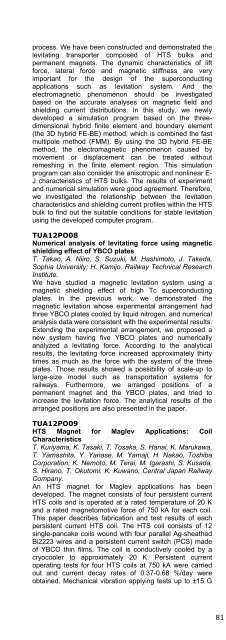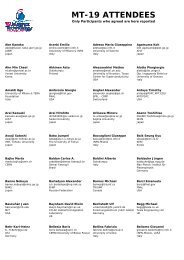Click here to download the abstract booklet in pdf format - MT19 - Infn
Click here to download the abstract booklet in pdf format - MT19 - Infn
Click here to download the abstract booklet in pdf format - MT19 - Infn
You also want an ePaper? Increase the reach of your titles
YUMPU automatically turns print PDFs into web optimized ePapers that Google loves.
process. We have been constructed and demonstrated <strong>the</strong><br />
levitat<strong>in</strong>g transporter composed of HTS bulks and<br />
permanent magnets. The dynamic characteristics of lift<br />
force, lateral force and magnetic stiffness are very<br />
important for <strong>the</strong> design of <strong>the</strong> superconduct<strong>in</strong>g<br />
applications such as levitation system. And <strong>the</strong><br />
electromagnetic phenomenon should be <strong>in</strong>vestigated<br />
based on <strong>the</strong> accurate analyses on magnetic field and<br />
shield<strong>in</strong>g current distributions. In this study, we newly<br />
developed a simulation program based on <strong>the</strong> threedimensional<br />
hybrid f<strong>in</strong>ite element and boundary element<br />
(<strong>the</strong> 3D hybrid FE-BE) method, which is comb<strong>in</strong>ed <strong>the</strong> fast<br />
multipole method (FMM). By us<strong>in</strong>g <strong>the</strong> 3D hybrid FE-BE<br />
method, <strong>the</strong> electromagnetic phenomenon caused by<br />
movement or displacement can be treated without<br />
remesh<strong>in</strong>g <strong>in</strong> <strong>the</strong> f<strong>in</strong>ite element region. This simulation<br />
program can also consider <strong>the</strong> anisotropic and nonl<strong>in</strong>ear E-<br />
J characteristics of HTS bulks. The results of experiment<br />
and numerical simulation were good agreement. T<strong>here</strong>fore,<br />
we <strong>in</strong>vestigated <strong>the</strong> relationship between <strong>the</strong> levitation<br />
characteristics and shield<strong>in</strong>g current profiles with<strong>in</strong> <strong>the</strong> HTS<br />
bulk <strong>to</strong> f<strong>in</strong>d out <strong>the</strong> suitable conditions for stable levitation<br />
us<strong>in</strong>g <strong>the</strong> developed computer program.<br />
TUA12PO08<br />
Numerical analysis of levitat<strong>in</strong>g force us<strong>in</strong>g magnetic<br />
shield<strong>in</strong>g effect of YBCO plates<br />
T. Takao, A. Niiro, S. Suzuki, M. Hashimo<strong>to</strong>, J. Takeda,<br />
Sophia University; H. Kamijo, Railway Technical Research<br />
Institute.<br />
We have studied a magnetic levitation system us<strong>in</strong>g a<br />
magnetic shield<strong>in</strong>g effect of high Tc superconduct<strong>in</strong>g<br />
plates. In <strong>the</strong> previous work, we demonstrated <strong>the</strong><br />
magnetic levitation whose experimental arrangement had<br />
three YBCO plates cooled by liquid nitrogen, and numerical<br />
analysis data were consistent with <strong>the</strong> experimental results.<br />
Extend<strong>in</strong>g <strong>the</strong> experimental arrangement, we proposed a<br />
new system hav<strong>in</strong>g five YBCO plates and numerically<br />
analyzed a levitat<strong>in</strong>g force. Accord<strong>in</strong>g <strong>to</strong> <strong>the</strong> analytical<br />
results, <strong>the</strong> levitat<strong>in</strong>g force <strong>in</strong>creased approximately thirty<br />
times as much as <strong>the</strong> force with <strong>the</strong> system of <strong>the</strong> three<br />
plates. Those results showed a possibility of scale-up <strong>to</strong><br />
large-size model such as transportation systems for<br />
railways. Fur<strong>the</strong>rmore, we arranged positions of a<br />
permanent magnet and <strong>the</strong> YBCO plates, and tried <strong>to</strong><br />
<strong>in</strong>crease <strong>the</strong> levitation force. The analytical results of <strong>the</strong><br />
arranged positions are also presented <strong>in</strong> <strong>the</strong> paper.<br />
TUA12PO09<br />
HTS Magnet for Maglev Applications: Coil<br />
Characteristics<br />
T. Kuriyama, K. Tasaki, T. Tosaka, S. Hanai, K. Marukawa,<br />
T. Yamashita, Y. Yanase, M. Yamaji, H. Nakao, Toshiba<br />
Corporation; K. Nemo<strong>to</strong>, M. Terai, M. Igarashi, S. Kusada,<br />
S. Hirano, T. Oku<strong>to</strong>mi, K. Kuwano, Central Japan Railway<br />
Company.<br />
An HTS magnet for Maglev applications has been<br />
developed. The magnet consists of four persistent current<br />
HTS coils and is operated at a rated temperature of 20 K<br />
and a rated magne<strong>to</strong>motive force of 750 kA for each coil.<br />
This paper describes fabrication and test results of each<br />
persistent current HTS coil. The HTS coil consists of 12<br />
s<strong>in</strong>gle-pancake coils wound with four parallel Ag-shea<strong>the</strong>d<br />
Bi2223 wires and a persistent current switch (PCS) made<br />
of YBCO th<strong>in</strong> films. The coil is conductively cooled by a<br />
cryocooler <strong>to</strong> approximately 20 K. Persistent current<br />
operat<strong>in</strong>g tests for four HTS coils at 750 kA were carried<br />
out and current decay rates of 0.37-0.68 %/day were<br />
obta<strong>in</strong>ed. Mechanical vibration apply<strong>in</strong>g tests up <strong>to</strong> ±15 G<br />
were carried out <strong>to</strong> <strong>in</strong>vestigate <strong>the</strong> mechanical properties of<br />
<strong>the</strong> HTS coils. Temperature <strong>in</strong>creas<strong>in</strong>g tests up <strong>to</strong> 25 K,<br />
which is 5 K higher than <strong>the</strong> rated operat<strong>in</strong>g temperature<br />
and higher magne<strong>to</strong>motive force operat<strong>in</strong>g tests up <strong>to</strong> 800<br />
kA were carried out <strong>to</strong> <strong>in</strong>vestigate <strong>the</strong> <strong>the</strong>rmal stability of<br />
<strong>the</strong> coils and check <strong>the</strong> mechanical strength of <strong>the</strong> coils.<br />
TUA12PO10<br />
HTS magnet for Maglev Applications: Magnet Structure<br />
and Performance<br />
M. Terai, M. Igarashi, K. Nemo<strong>to</strong>, S. Kusada, T. Oku<strong>to</strong>mi,<br />
K. Kuwano, S. Hirano, Central Japan Railway Company; T.<br />
Yamashita, Y. Yanase, S. Hanai, K. Marukawa, T.<br />
Kuriyama, K. Tasaki, T. Tosaka, M.Yamaji, H. Nakano,<br />
Toshiba Corporation.<br />
An HTS magnet for Maglev applications has been<br />
developed. The HTS magnet is an actual device for a<br />
Maglev vehicle and consists of four persistent current HTS<br />
coils. The magnet is operated at a rated temperature of 20<br />
K and a rated magne<strong>to</strong>motive force of 750 kA for each coil.<br />
This paper describes structure and performance test<br />
results of <strong>the</strong> HTS magnet. These four HTS coils were<br />
<strong>in</strong>stalled <strong>in</strong> a cryostat for a Maglev vehicle and conductively<br />
cooled by two sets of two-stage GM type pulse tube<br />
cryocoolers below 20 K. Detachable current-leads, which<br />
consist of copper alloy leads and ultrasonic mo<strong>to</strong>rs, are<br />
used <strong>to</strong> reduce heat leakage <strong>to</strong> <strong>the</strong> 1st stages of <strong>the</strong><br />
cryocoolers. These four HTS coils were simultaneously<br />
charged up <strong>to</strong> <strong>the</strong> rated magne<strong>to</strong>motive force. Persistent<br />
current operat<strong>in</strong>g tests were carried out and <strong>the</strong> current<br />
decay rates were measured. To observe <strong>the</strong> mechanical<br />
capability of <strong>the</strong> magnet, vibration tests were carried out.<br />
The HTS magnet will be <strong>in</strong>stalled <strong>to</strong> <strong>the</strong> vehicle of <strong>the</strong><br />
Yamanashi Maglev test l<strong>in</strong>e.<br />
PARALLEL SESSION 15:50 – 18:00<br />
(Maestrale room)<br />
MgB2<br />
TUA1OR1<br />
Development of MgB2conduc<strong>to</strong>rs for AC applications<br />
G. Grasso, A. Malagoli, INFM-LAMIA & Columbus<br />
Superconduc<strong>to</strong>rs srl; A. Tum<strong>in</strong>o, V. Bracc<strong>in</strong>i, M. Tropeano,<br />
C. Fanciulli, M. Vignolo, A. S. Siri, INFM-LAMIA; M. Bocchi,<br />
L. Mart<strong>in</strong>i; CESI SPA.<br />
In spite of its recent discovery, MgB2 conduc<strong>to</strong>rs are<br />
already fabricated <strong>in</strong> very long lengths for low- <strong>to</strong> medium<br />
magnetic field generation <strong>in</strong> w<strong>in</strong>d<strong>in</strong>gs operated <strong>in</strong> DC<br />
condition. The possibility of us<strong>in</strong>g MgB2 <strong>in</strong> power<br />
applications is related <strong>to</strong> <strong>the</strong> capability of manufactur<strong>in</strong>g<br />
superconduct<strong>in</strong>g wires with m<strong>in</strong>imized AC losses, and with<br />
sheath materials show<strong>in</strong>g mechanical, electrical, magnetic,<br />
and <strong>the</strong>rmal properties desirable for a selected device.<br />
Consider<strong>in</strong>g <strong>the</strong> present behaviour of MgB2 <strong>in</strong> a magnetic<br />
field, <strong>the</strong> first power applications that is possible <strong>to</strong> target<br />
are Superconduct<strong>in</strong>g Fault Current Limiters (SFCL), and<br />
Transformers, that <strong>in</strong>volve a conduc<strong>to</strong>r <strong>in</strong> self-field<br />
condition, and <strong>in</strong> a field of a few tenth of Tesla,<br />
respectively. In order <strong>to</strong> make <strong>the</strong> use of MgB2 attractive at<br />
low temperatures (20K-30K), it is vital <strong>to</strong> dramatically<br />
reduce its AC losses <strong>to</strong> m<strong>in</strong>imize <strong>the</strong> extra cool<strong>in</strong>g costs.<br />
The sheath material choice is much wider than for o<strong>the</strong>r<br />
HTS compounds, as MgB2 shows a much broader<br />
chemical compatibility with various elements. Nonmagnetic<br />
and high electrical resistivity alloys can be<br />
selected <strong>to</strong> constitute <strong>the</strong> sheath material. First results on<br />
<strong>the</strong> optimization of <strong>the</strong> filament configuration, twist<strong>in</strong>g, and<br />
81 MT-19 2005, Genova



